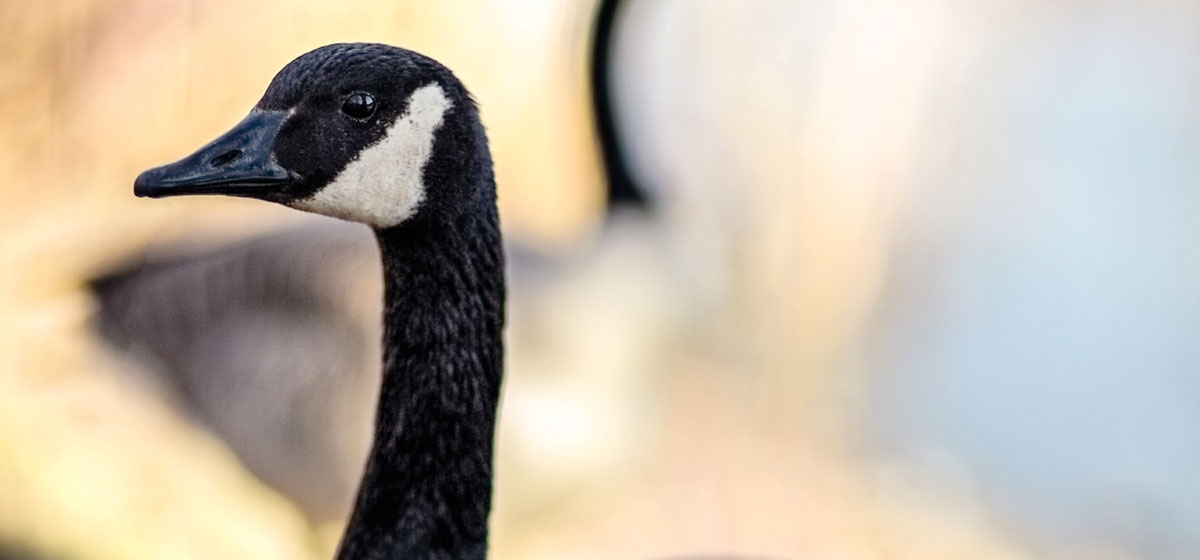
One fall evening in New England when I was an undergraduate, I heard honking so loud it had the force of an approaching train, lasting for several minutes as geese flew by. They faded into the night but have stayed with me since.
I’ve stood under a rising gaggle of geese and felt the push of air, watched the heaving of their chests as they rose into the sky. I’ve watched them on a pond in spring, their necks low and extended, chasing each other for dominance. I’ve freed a gosling from a chain link fence behind the Waterworks in Fox Chapel as its parents hissed with open, red mouths. The infant was plush, its feathers waxy and body warm under its natal down. I’ve seen a guy slam the brakes of his pickup to usher geese across Freeport Road.
The bane of golf course keepers and office park grounds crews, these geese are large and impressive, they reproduce successfully, and they’re less and less migratory. Common as they are, however, they enthrall me. They’re not stuffed animals or toys. They’re funny, beautiful, messy, aggressive and sometimes scary. And they’re wild.
The Canada goose can be found year-round in many corners of the region. With our rivers, ponds and grassy suburbs, we’re good habitat for these mainly herbivorous birds. Plants, grasses and seeds are a goose’s favorite forage, so lack of snow cover in warmer winters with attendant open water and well-tended fairways make for prime grazing range. They also like the occasional insect, water critter or small fish. But if you think of a cow in feathers, you’ll get the idea.
As with bovines, with all that grazing comes poop. Whether on the North Shore, in parks or on playing fields, geese leave evidence of their passing that gets some people a bit upset. There is relatively low health risk, and it is natural fertilizer, but excessive goose poop is a reason some Pittsburgh residents accept the killing of geese, as happened in North Park in 2007, when some 300 geese were culled to control a burgeoning population there.
It could be worse, however. After US Airways Flight 1549 lost both engines to multiple Canada goose strikes on takeoff from LaGuardia Airport in 2009, many hundreds, perhaps thousands, of geese were culled all over the New York City area. The last time a jet in Pittsburgh hit a Canada goose was in 2002, and the plane kept flying. So the geese can breathe a sigh of relief, as can anyone who flies out of Allegheny County. (The FAA maintains a fascinating searchable database of bird strikes by airport and bird species at faa.gov).
Pittsburgh’s geese are largely the Common or Giant geese that stand almost 4 feet tall, with a wingspan of 5 feet. Our geese weigh in around 10 pounds, which makes their bulk the largest of the six distinct populations found in North America. Other subspecies—the Aleutian, Cackling, Dusky and Lesser Canada goose among them—range in height from just over 2 feet on up, with wingspans from 4-to-5½ feet and weight in the 3-to-7-pound range. Those populations tend to be west of us, in the central and Pacific flyways.
Our resident population is largely non-migratory, taking short flights of 10 or 20 miles, sometimes at 60 miles an hour. They return to a home territory to feed, breed and live. No matter the population, all share brownish-gray upper bodies, whitish-gray bellies, black necks, dark tails and white cheeks. But the bill length varies by population, as does the general profile, depending on body size.
Canada geese typically live 15 to 20 years, with the record being 28 years. It’s legal to take as many as five a day with the proper waterfowl hunting permits in season. And while Canada geese populations are significant in Pennsylvania, oddly, no Canada geese nested anywhere in the state before 1935. Today, they nest statewide. Young are hatched in spring; precocial, ready to waddle, swim, eat, feed and poop within a day. Their parents generally mate for life, so no doubt we’ll see more young ones in just a few months.


